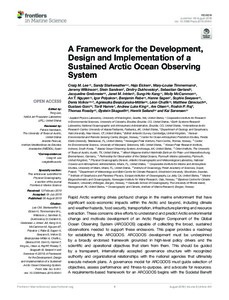| dc.contributor.author | Lee, C.M. | |
| dc.contributor.author | Starkweather, S. | |
| dc.contributor.author | Eicken, H. | |
| dc.contributor.author | Timmermans, M-L. | |
| dc.contributor.author | Wilkinson, J. | |
| dc.contributor.author | Sandven, S. | |
| dc.contributor.author | Dukhovskoy, D. | |
| dc.contributor.author | Gerland, S. | |
| dc.contributor.author | Grebmeier, J. | |
| dc.contributor.author | Intrieri, J.M. | |
| dc.contributor.author | Kang, S-H. | |
| dc.contributor.author | McCammon, M. | |
| dc.contributor.author | Nguyen, A.T. | |
| dc.contributor.author | Polyakov, I. | |
| dc.contributor.author | Rabe, B. | |
| dc.contributor.author | Sagen, H. | |
| dc.contributor.author | Seeyave, S. | |
| dc.contributor.author | Volkov, D. | |
| dc.contributor.author | Beszczynska-Möller, A. | |
| dc.contributor.author | Chafik, L. | |
| dc.contributor.author | Dzieciuch, M. | |
| dc.contributor.author | Goni, G. | |
| dc.contributor.author | Hamre, T. | |
| dc.contributor.author | King, A.L. | |
| dc.contributor.author | Olsen, A. | |
| dc.contributor.author | Raj, R.P. | |
| dc.contributor.author | Rossby, T. | |
| dc.contributor.author | Skagseth, Ø. | |
| dc.contributor.author | Søiland, H. | |
| dc.contributor.author | Sørensen, K. | |
| dc.coverage.spatial | Arctic Region | en_US |
| dc.date.accessioned | 2020-05-03T18:51:26Z | |
| dc.date.available | 2020-05-03T18:51:26Z | |
| dc.date.issued | 2019 | |
| dc.identifier.citation | Lee, Craig M.,et al (2019) A Framework for the Development, Design and Implementation of a Sustained Arctic Ocean Observing System. Frontiers in Marine Science, 6: 451, 21pp. DOI: 10.3389/fmars.2019.00451 | en_US |
| dc.identifier.uri | http://hdl.handle.net/11329/1322 | |
| dc.identifier.uri | http://dx.doi.org/10.25607/OBP-830 | |
| dc.description.abstract | Rapid Arctic warming drives profound change in the marine environment that have
significant socio-economic impacts within the Arctic and beyond, including climate
and weather hazards, food security, transportation, infrastructure planning and resource
extraction. These concerns drive efforts to understand and predict Arctic environmental
change and motivate development of an Arctic Region Component of the Global
Ocean Observing System (ARCGOOS) capable of collecting the broad, sustained
observations needed to support these endeavors. This paper provides a roadmap
for establishing the ARCGOOS. ARCGOOS development must be underpinned
by a broadly endorsed framework grounded in high-level policy drivers and the
scientific and operational objectives that stem from them. This should be guided
by a transparent, internationally accepted governance structure with recognized
authority and organizational relationships with the national agencies that ultimately
execute network plans. A governance model for ARCGOOS must guide selection of
objectives, assess performance and fitness-to-purpose, and advocate for resources.
A requirements-based framework for an ARCGOOS begins with the Societal Benefit Areas (SBAs) that underpin the system. SBAs motivate investments and define the
system’s science and operational objectives. Objectives can then be used to identify
key observables and their scope. The domains of planning/policy, strategy, and tactics
define scope ranging from decades and basins to focused observing with near real time
data delivery. Patterns emerge when this analysis is integrated across an appropriate
set of SBAs and science/operational objectives, identifying impactful variables and the
scope of the measurements. When weighted for technological readiness and logistical
feasibility, this can be used to select Essential ARCGOOS Variables, analogous to
Essential Ocean Variables of the Global Ocean Observing System. The Arctic presents
distinct needs and challenges, demanding novel observing strategies. Cost, traceability
and ability to integrate region-specific knowledge have to be balanced, in an approach
that builds on existing and new observing infrastructure. ARCGOOS should benefit
from established data infrastructures following the Findable, Accessible, Interoperable,
Reuseable Principles to ensure preservation and sharing of data and derived products.
Linking to the Sustaining Arctic Observing Networks (SAON) process and involving
Arctic stakeholders, for example through liaison with the International Arctic Science
Committee (IASC), can help ensure success. | en_US |
| dc.language.iso | en | en_US |
| dc.rights | Attribution 4.0 International | * |
| dc.rights.uri | http://creativecommons.org/licenses/by/4.0/ | * |
| dc.subject.other | Sustaining Arctic Observing Network (SAON) | en_US |
| dc.subject.other | Autonomous platforms | en_US |
| dc.subject.other | Observing system design | en_US |
| dc.subject.other | ARCGOOS | en_US |
| dc.subject.other | Societal benefit areas | en_US |
| dc.subject.other | Global Ocean Observing System (GOOS) | en_US |
| dc.subject.other | Essential ocean variables | en_US |
| dc.title | A Framework for the Development, Design and Implementation of a Sustained Arctic Ocean Observing System. | en_US |
| dc.type | Journal Contribution | en_US |
| dc.description.notes | Oceanobs'19: An Ocean of Opportunity Community White Paper | en_US |
| dc.description.refereed | Refereed | en_US |
| dc.format.pagerange | 21pp. | en_US |
| dc.identifier.doi | 10.3389/fmars.2019.00451 | |
| dc.subject.parameterDiscipline | Parameter Discipline::Cross-discipline | en_US |
| dc.bibliographicCitation.title | Frontiers in Marine Science | en_US |
| dc.bibliographicCitation.volume | 6 | en_US |
| dc.bibliographicCitation.issue | Article 451 | en_US |
| dc.description.sdg | 14.A | en_US |
| dc.description.bptype | Manual (incl. handbook, guide, cookbook etc) | en_US |
| obps.contact.contactemail | craiglee@uw.edu | |
| obps.resourceurl.publisher | https://www.frontiersin.org/articles/10.3389/fmars.2019.00451/full | en_US |
 Repository of community practices in Ocean Research, Applications and Data/Information Management
Repository of community practices in Ocean Research, Applications and Data/Information Management

